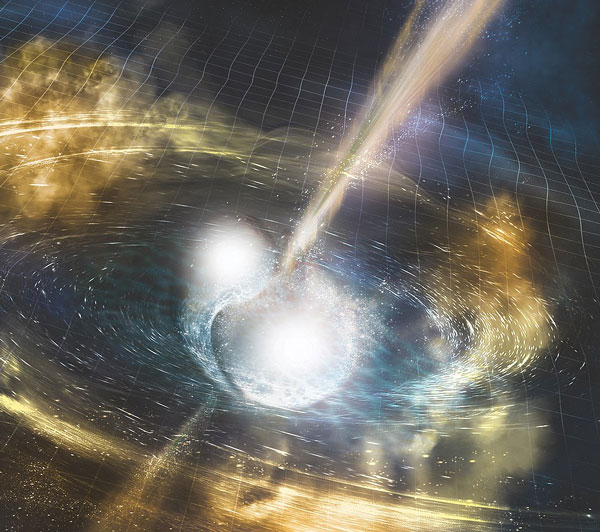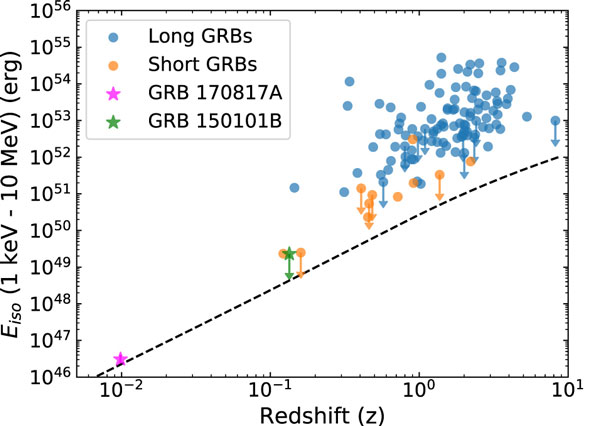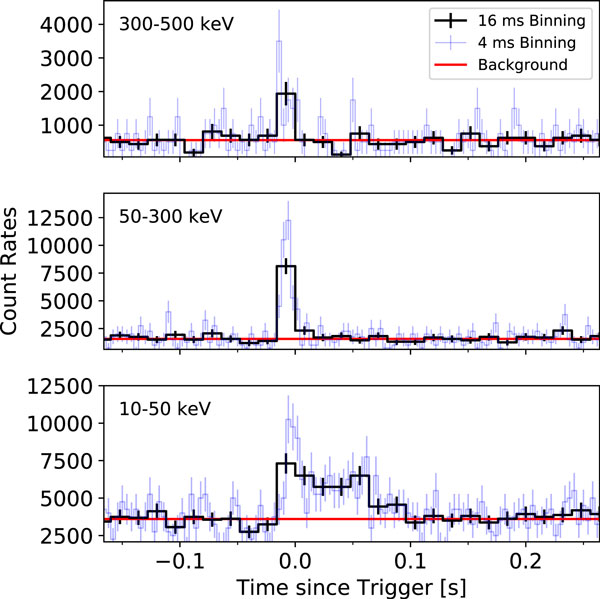High-energy radiation released during the merger of two neutron stars last year has left astronomers puzzled. Could a burst of gamma rays from 2015 help us to piece together a coherent picture of both explosions?

NSF/LIGO/Sonoma State University/A. Simonnet
A Burst Alone?
When two neutron stars collided last August, forming a distinctive gravitational-wave signal and a burst of radiation detected by telescopes around the world, scientists knew that these observations would change our understanding of short gamma-ray bursts (GRBs). Though we’d previously observed thousands of GRBs, GRB 170817A was the first to have such a broad range of complementary observations — both in gravitational waves and across the electromagnetic spectrum — providing insight into its origin.

Adapted from Burns et al. 2018
But it quickly became evident that GRB 170817A was not your typical GRB. For starters, this burst was unusually weak, appearing 1,000 times less luminous than a typical short GRB. Additionally, the behavior of this burst was unusual: instead of having only a single component, the ~2-second explosion exhibited two distinct components — first a short, hard (higher-energy) spike, and then a longer, soft (lower-energy) tail.
The peculiarities of GRB 170817A prompted a slew of models explaining its unusual appearance. Ultimately, the question is: can our interpretations of GRB 170817A safely be applied to the general population of gamma-ray bursts? Or must we assume that GRB 170817A is a unique event, not representative of the general population?
New analysis of a GRB from 2015 — presented in a recent study led by Eric Burns (NASA Goddard SFC) — may help to answer this question.
A Matter of Angles
What does a burst from 2015 have to do with the curious case of GRB 170817A? Burns and collaborators have demonstrated that this 2015 burst, GRB 150101B, exhibited the same strange behavior as GRB 170817A: its emission can be broken down into two components consisting of a short, hard spike, followed by a long, soft tail. Unlike GRB 170817A, however, GRB 150101B is not underluminous — and it lasted less than a tenth of the time.

Burns et al. 2018
Intriguingly, these similarities and differences can all be explained by a single model. Burns and collaborators propose that GRB 150101B and GRB 170817A exhibit the exact same two-component behavior, and their differences in luminosity and duration can be explained by quirks of special relativity.
High-speed outflows such as these will have different apparent luminosities and durations depending on whether we view them along their axis or slightly from the side. Burns and collaborators demonstrate that these the two bursts could easily have the same profile — but GRB 150101B was viewed nearly on-axis, whereas GRB 170817A was viewed from an angle.
If this is true, then perhaps more GRBs have hard spikes and soft tails similar to these two; the tails may just be difficult to detect in more distant bursts. While more work remains to be done, the recognition that GRB 170817A may not be unique is an important one for understanding both its behavior and that of other short GRBs.
Citation
“Fermi GBM Observations of GRB 150101B: A Second Nearby Event with a Short Hard Spike and a Soft Tail,” E. Burns et al 2018 ApJL 863 L34. doi:10.3847/2041-8213/aad813
This post originally appeared on AAS Nova, which features research highlights from the journals of the American Astronomical Society.
 0
0









Comments
You must be logged in to post a comment.